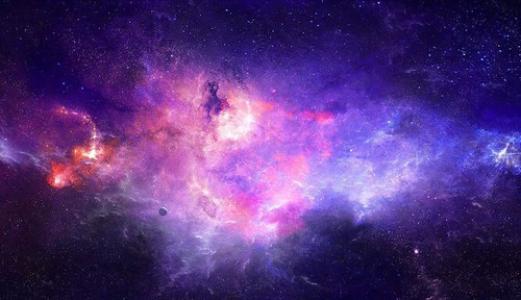For a long time, there was a strange mystery when it came to the question of how galaxies formed:
长期以来,星系的形成过程一直是个让人百思不得其解的谜题。
The best models predicted that a whole galaxy would form at the same time, but ... galaxies have stars with all kinds of different ages.
一些最佳模型显示:某个星系可以骤然形成,但星系中的恒星并非同时形成的。
So how do we explain that?
这又是怎么回事呢?

Turns out that galaxies eat each other.
原来是因为星系会互相侵食。
We used to think that galaxies formed when huge clouds of gas in space collapsed inwards under the weight of their own gravity.
以前,我们以为星系形成的条件是:宇宙里的大型气体云在各自重力的牵引下发生坍缩。
Denser pockets of that cloud became stars, and most of the stars then got pulled into the center of the new galaxy by gravity.
气体云密度较大的部分就成了恒星,而大多数恒星都受到重力的牵引作用,来到了新星系的中心部分。
This is known as the primordial collapse model of galaxy formation, and it’s not wrong.
这就是星系形成的原始坍缩模型,而且这个模型不无道理。
Clusters of stars do form that way, and some of those clusters are big enough that you could call them galaxies.
星团确实会以这种方式形成,而且其中一些星团非常大,就成了人们口中的星系。
But if primordial collapse were all there was to it, then all of the stars in each galaxy should be about the same age, since they would have formed at about the same time.
但如果原始坍缩就是问题的唯一原因的话,那么每个星系里的所有恒星都应该年龄相同,因为他们肯定是同一时间形成的。
Except ... they’re not.
但事实并非如此。
For example, the oldest stars in the Milky Way are more than 13 billion years old.
比如,银河系里年龄最大的恒星已经有130多亿岁了。
Meanwhile, our Sun is only about four and a half billion years old. And in other places in the galaxy, new baby stars are forming right now.
与此同时,地球只有45亿岁。而且银河系其他地方此时此刻还在有新的小恒星诞生。
The best explanation for how all these differently-aged stars can show up in the same galaxy is that they originally came from other galaxies – which then merged into one.
对于同个星系中恒星年龄各不相同的最好解释就是:这些恒星一开始是来自不同星系的——最后这些星系合成了一个。
When two galaxies are close enough, they're affected by each other’s gravity.
两个星系距离十分接近时,就会受到彼此引力的影响。
And if those two galaxies are of roughly the same size, they’ll eventually merge.
而如果这两个星系大小差不多的话,他们就会合并。
The new galaxy formed during that merger will be much bigger, with twice the mass of either of its parent galaxies.
经过合并产生的星系,体型会更大,质量是这两个星系中任何一个的两倍。
And it'll have stars that could potentially be of vastly different ages, depending on the ages of its parents.
新形成星系中的恒星也会有不同年龄段的,这取决于原来星系的年龄。
That new galaxy might then be attracted towards another galaxy, and eventually they would end up merging, too.
新形成的星系可能会受到另一个星系的吸引,最终再次合并在一起。
Eventually, you could end up with truly massive galaxies.
最后,就会有很多特大质量的星系。
All this merging is appropriately called the hierarchical merger model of galaxy formation, and it’s how we now think galaxies grow.
这种合并过程可以称为星系形成的分层合并模式,这也是我们目前认定的星系形成过程。
Smaller things merge to make bigger things, which then merge to make even bigger things.
小物体可以合并为大一些的物体,然后越合并越大。
But that's just galaxies combining – neither of them really get destroyed.
但这只是星系合并,并不会让原来的星系消失。
So it's not what scientists mean when they talk about galactic cannibalism.
所以,科学家说的星系吞食现象并不是字面意思。
Instead, they're referring to what happens when one galaxy is a lot bigger than the other.
他们指的是:一个星系要比另一个星系大很多。
Because in those situations, the bigger galaxy rips the smaller galaxy apart, sucking in its stars and dust and its dark matter halo, and leaving just a trail of star-crumbs behind.
因为在这种情况下,大一些的星系会让小星系结构发生改变,并吸引一部分小星系的恒星、尘土和暗物质光晕,留下一些零零碎碎的小恒星。
That's galactic cannibalism -- and it's actually really common.
这就是星系吞食现象,而且这种现象十分常见。
Like, the Milky Way is in the process of cannibalizing at least four different smaller galaxies right now.
比如,现在的银河系正在吞食至少4个比它小的星系。
First, there’s the Sagittarius dwarf galaxy, which we’re in the final stages of consuming.
首当其冲的是人马矮星系,现在已经进入“香消玉殒”的最后阶段了。
Once upon a time, this was one of the Milky Way’s brightest satellite galaxies.
曾几何时,人马矮星系是银河系里最亮的卫星星系。
But over the past billion years, the Milky Way has dispersed and absorbed half of its stars and nearly all of its clouds of gas.
但在过去数十亿年间,银河系将人马矮星系里的恒星打乱,并吸收了其中的半数恒星以及几乎所有的气体云。
The prognosis for the rest of this dwarf galaxy isn’t good, either: it’s still being pulled apart by the Milky Way’s gravity.
人马矮星系的未来依然不是很明朗,因为目前它还在不断受到银河系引力作用的吞食。
There’s also the Canis Major dwarf galaxy, which was only discovered in 1994 despite being our closest galactic neighbor, at only 48 thousand light years away.
其二是大犬矮星系,虽然他是银河系里离我们最近的星系(仅4.8万光年),但直到1994年,科学家才发现它。
That's because it's pretty much gone.
这是因为大犬矮星系已经被吞食的差不多了。
It’s been pulled to pieces by the Milky Way’s gravity so totally that, when it was first discovered, scientists weren’t even sure if it was a galaxy.
银河系对它的引力作用太过强大,导致它分崩离析,所以当科学家首次发现它的时候,还不太确定这是否是个星系。
Some of them thought it was just a weird bump on one of the Milky Way’s arms.
一些科学家认为,大犬矮星系只是银河系旋臂上突出的一块而已。
And then there’s the Large and Small Magellanic Clouds, which we’ve only just started to snack on.
其三是麦哲伦云,这个目标,银河系还没怎么开始下手。
Like the others, these are dwarf galaxies that orbit the Milky Way.
跟其他矮星系一样,这三个星系都是围绕银河系运行的。
And according to a study published in 2014 by the Oxford University Press, they’re already beginning to deform as the Milky Way pulls them inwards.
根据牛津大学出版社2014年发表的一则研究,这三个星系已经开始在银河系的作用下变形。
The astronomers who wrote the paper, who are based out of the University of Western Australia, gave these beautiful space-clouds about four billion years before they’re just another snack for the Milky Way.
这篇文章的作者主要在西澳大利亚大学做科研,他们认为,该星系还有大概40亿年的时间,就要为银河系所合并。
But the Milky Way will eventually get its comeuppance, when it’s devoured by the larger Andromeda Galaxy in about five billion years.
但银河系自己也将无法独善其身,因为再过50亿年,它就要被更大的仙女座星系所吞食。
The Andromeda galaxy, in turn, will most likely merge into a massive conglomeration of all of the galaxies in the Virgo cluster...
接下来,仙女座星系会合并到处女座星系中。
and they might end up being eaten by the Shapley Supercluster, a collection of galaxies about 650 million light years away..
最后,他们会被夏普力超星系团所吞食,后者是一个距离银河系6.5亿光年的星系群。
But that doesn't necessarily mean that every star and galaxy in the universe will eventually end up in a giant, terrifying cannibal star-blob.
但我说这些并不代表宇宙里的每颗恒星和每个星系都会变成一个可怕的大型恒星吞食机器。
That's because the universe is expanding, and the force of gravity decreases the farther away two objects get.
这是因为宇宙是不断扩张的,而引力的作用会随着物体距离的增加而减少。
So as the space between galaxies increases, mergers and collisions get less and less common.
所以,随着星系间距离的增加,合并和碰撞现象就会越来越少。
Across great enough distances, the power of attraction of even the most massive objects in the universe won’t be strong enough to overcome the speed of the universe’s expansion.
如果距离足够远,那么即便物体的质量很大,它们之间的引力作用也不会很强,比不上宇宙扩张的速度。
But until we reach that point...it’s a dog eat dog world out there. Even when the dogs are galaxies.
但在那一天到来之前,宇宙依然是一个大鱼吃小鱼的地方,而鱼就是星系。
Thanks for watching this episode of SciShow Space, and thanks especially to our patrons on Patreon who help make this show possible.
感谢收看本期的《太空科学秀》,尤其要感谢我们的忠实粉丝,是你们支持了节目的长期运转。
If you want to help us keep making episodes like this, just go to patreon.com/scishow to learn more. And don’t forget to go to youtube.com/scishowspace and subscribe!
如果您想助力我们制作类似本期的视频,可以登录patreon.com/scishow以了解更多。不要忘记订阅youtube.com/scishowspace哦!












